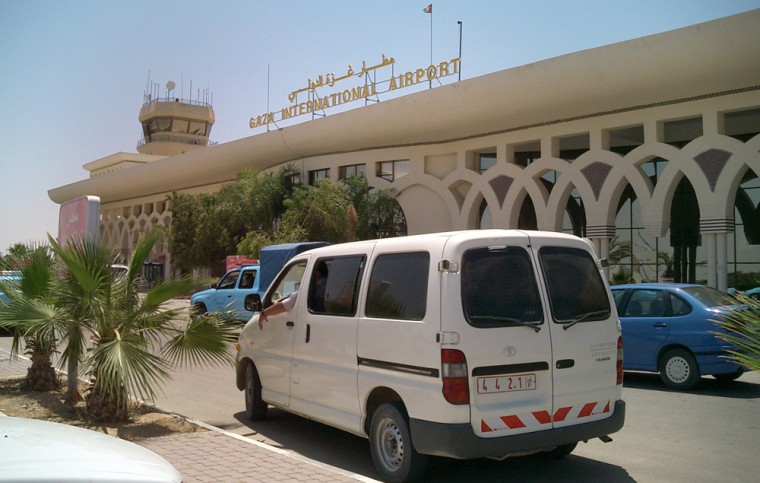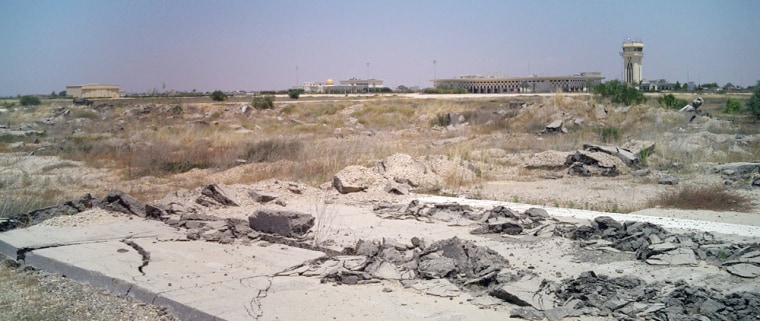Abu Ali stared at the empty chamber made of stone and marble and shrugged his shoulders. “This place is like my house, and it’s destroyed,” said the 53-year old Palestinian.
The “house” to which he was referring is the Yasser Arafat International Airport, in the southern Gaza Strip.
Ali, the head of airport security, was standing in the arrivals hall, near a luggage conveyor belt across from two passport control booths. Next to them sat a new computer system on polished floors. The nearby well-furnished VIP lounge had fluffy pillows and was noticeably dust-free. In fact, everything looked as new as it did when the airport opened for business in 1998.
But it has been five years since the equipment has seen any use. The airport was shut down in 2000, shortly after the beginning of the second intifada or uprising. It has languished since, a symbol of lapsed potential — the potential of peace, of progress, and of statehood.
Promises long ago
Seven years ago, Air Force One, ferrying U.S. President Bill Clinton, touched down on the Gaza landing strip, heralding a new era for the 1.3 million Palestinian people crammed into the tiny stretch of land measuring 135 square miles. Finally, they could fly in and out of Gaza — up to half a million Palestinians every year, in fact.
The $86 million shiny new facility also showed off Palestinian enterprise.
With funding from Egypt, Saudi Arabia, Spain, and Germany, as well as the aid of Moroccan architects, the airport boasted intricately designed ceilings and walls and state of the art equipment.
Seven hundred people working at the airport moved passengers and cargo from Gaza to neighboring Egypt and Jordan, the Gulf States, Saudi Arabia, Morocco, Turkey, and Cyprus. Jet planes the size of a Boeing 727 could land on the single runway.
Just before the uprising, the Palestinian Civil Aviation Authority had worked out an agreement for flights to and from Rome, according to Captain Salman Abu Halib, the airport’s director-general and chairman of the Palestinian Civil Aviation Authority.
The heady days of air travel, however, were short-lived. As fighting intensified from 2000 onwards, Israel tightened restrictions on Palestinians moving in and out of Gaza and the West Bank and shut the airport.
Through 2001 and early 2002, Israeli air strikes chipped away the shiny edges of what was once an emblem of prospective statehood.
Amid Israel’s concerns that the Palestinians would attempt to smuggle in weapons and terrorists, the runway, radar station, and exterior camera security system were all destroyed.
But, the Israelis were very thorough; they sent armoured bulldozers onto the runway to dig up the concrete into 17 separate pieces.
The ghost airport
Three years later, a stroll around the airport reveals a renewed sense of hope. Every day, some 400 employees show up to work. They are paid a regular, if minimum, salary by the Palestinian Authority.
Ali, the head of security, admits there isn’t much to do, but the staff is diligent about keeping the airport functional.

“We’re trying to keep things safe and ready for whenever the airport reopens,” said Ali.
Every two days, he says, they run everything — the luggage carousel, the security cameras, the x-ray machines, even the arrival/departure boards.
Of course, there is no aircraft to look after. The small fleet of Palestinian Airways’ planes is deployed around the region and in Europe while the airport remains closed.
One reason Palestinians working at the airport are optimistic about its future is the planned Israeli withdrawal from Gaza, due in mid-August after being postponed once from July. The details have yet to be worked out, but Ali and other Palestinians are hoping the airport will be one of the first issues to be addressed on the post-withdrawal agenda.
“We don’t know what the Israelis will or will not do,” said Halib, the head of the Palestinian Civil Aviation Authority, but he maintains the Palestinian economy needs the airport to be rebuilt and reopened as soon as possible. The Palestinians say $22 million worth of airport property was destroyed and estimate revenue losses to be around $350 million.
A murky future
Israel, however, views the situation differently. “A seaport is more important to the Palestinians and the Palestinian economy,” said Shlomo Dror, spokesman for the Coordinator of Government Activities in the Territories at the Israeli Ministry of Defense.
According to Dror, ongoing discussions between the two sides have centered around finding a location for new port facilities, perhaps in the northern Gaza Strip, and not around the airport.
“The airport does not contribute to the Palestinian economy,” said Dror, who argues that most Palestinians did not benefit from the airport, only diplomats and VIPs who could fly directly instead of having to travel out of the region via Egypt or Jordan.
Moreover, “we had a lot of problems in the past with the airport,” added the Israeli spokesman.
In fact, despite all appearances, Israel was always supposed to be in charge of the facility, as stipulated by the Interim Agreement on the West Bank and Gaza Strip from 1995. Palestinian and Israeli aviation authorities were to cooperate on flight operations as well as airport security.
The Israelis say the Palestinians failed to honor that agreement. “We are the ones actually responsible for everyone coming in and getting out of the West Bank and Gaza,” said Dror. “[But the airport] was a way to bypass the Interim Agreement, that the Palestinians can take out people without our notice and without our security checks, and bring in weapons or things like that.”
But the Palestinians insist security is not the issue. “The problem with Israel is not security,” says Halib. “The problem is they want to continue to punish us. They always had control.”
Israel vetted all flight manifestsand monitored all flights into Gaza, said Lt. Sharif Nahhal of the Palestinian Presidential Guard, a special armed forces unit based at the airport.
In the arrivals hall, Ali, the airport security chief, points to a room that housed Israeli officials who could come in anytime to check arriving passengers and cargo.
But talks over re-opening the airport might be forestalled if the Israeli pull-out from Gaza is delayed a second time. Tensions have resurfaced this past week, threatening the fragile three-month ceasefire.
Palestinian militants have stepped up mortar fire and shelling directed at Jewish settlements in Gaza, prompting a missile attack from Israel on Wednesday, the first such air strike since the truce was agreed in early February.
Israeli media reports suggest if the violence persists, the Israeli government may re-visit the withdrawal timetable.
Even if Israel agrees to allow the airport to reopen, it would be at least nine months before it could be operational. In the meantime, the staff remain hopeful even as their jobs have lost a bit of their lustre over the years.
"Politics is another world," said Nahhal, who once oversaw Yasser Arafat’s protection service at the airport but is now reduced to hosting the occasional diplomatic delegation touring the facility. "It’s not my business. I just keep the [VIP lounge] clean and running."
Ali similarly prowls around the empty halls. "I feel like this is a museum walk," he says, wryly. "I am like a tourism guard. A general manager of airport museum walks."
